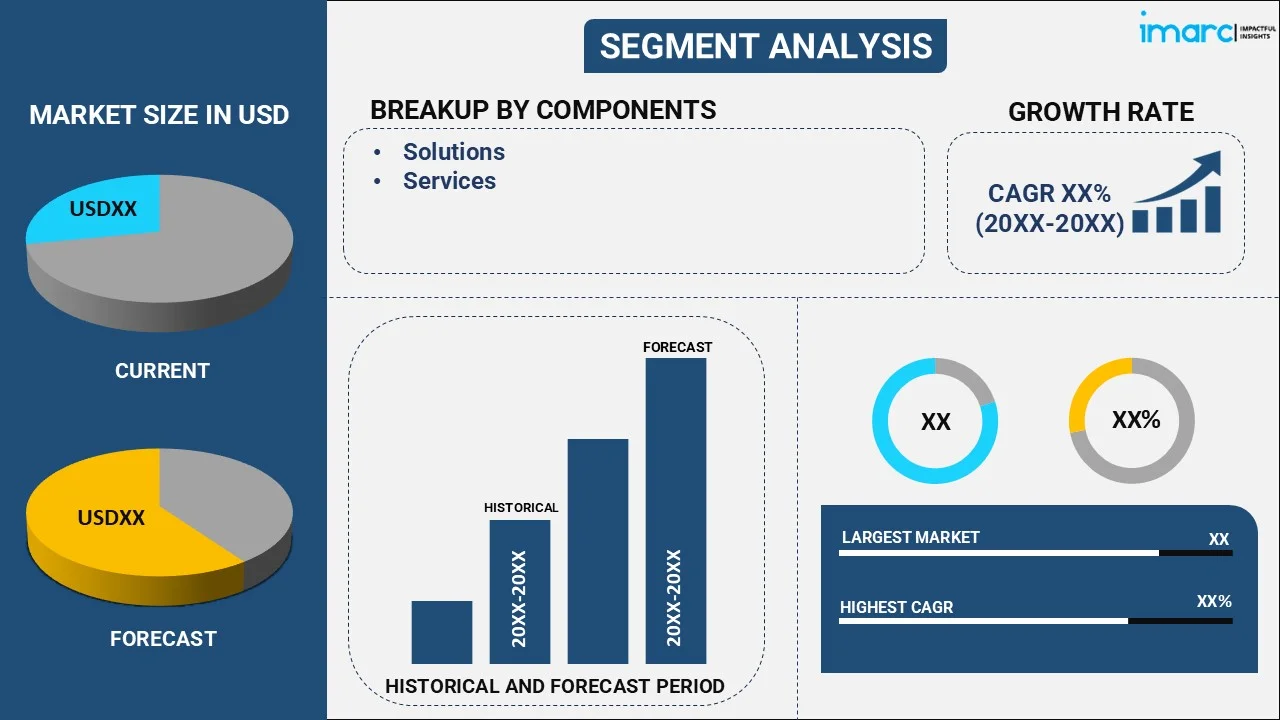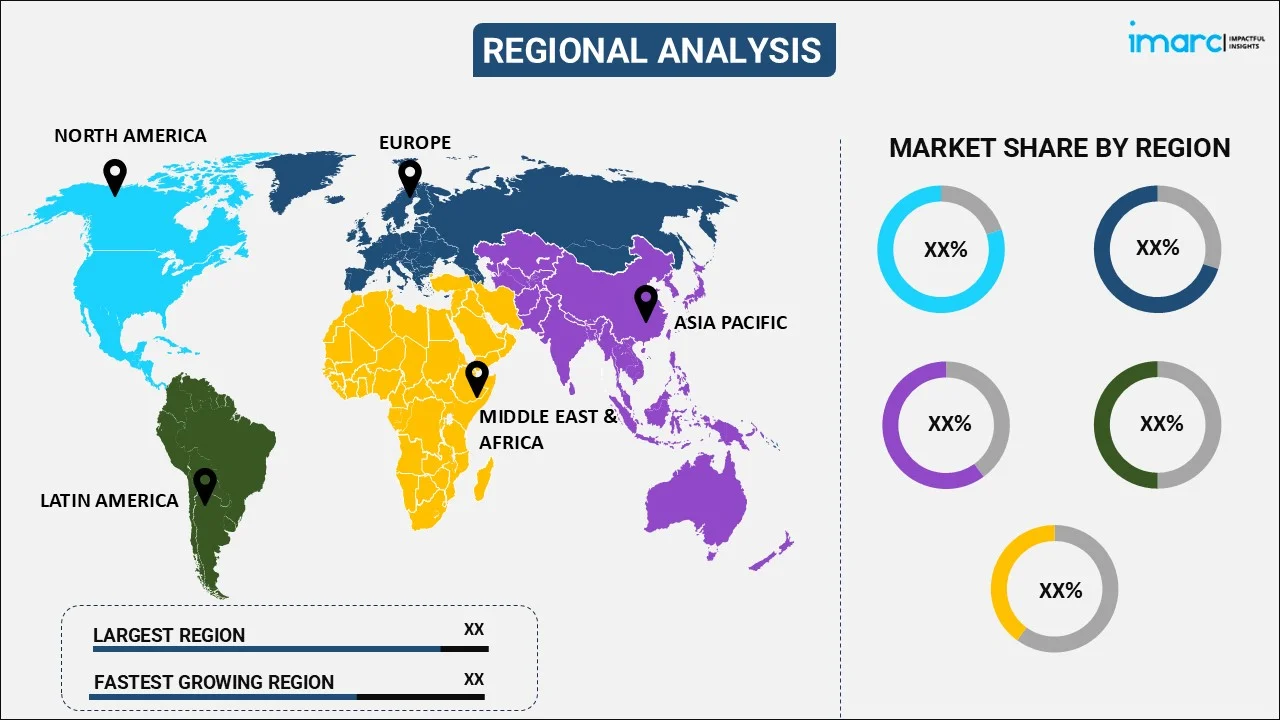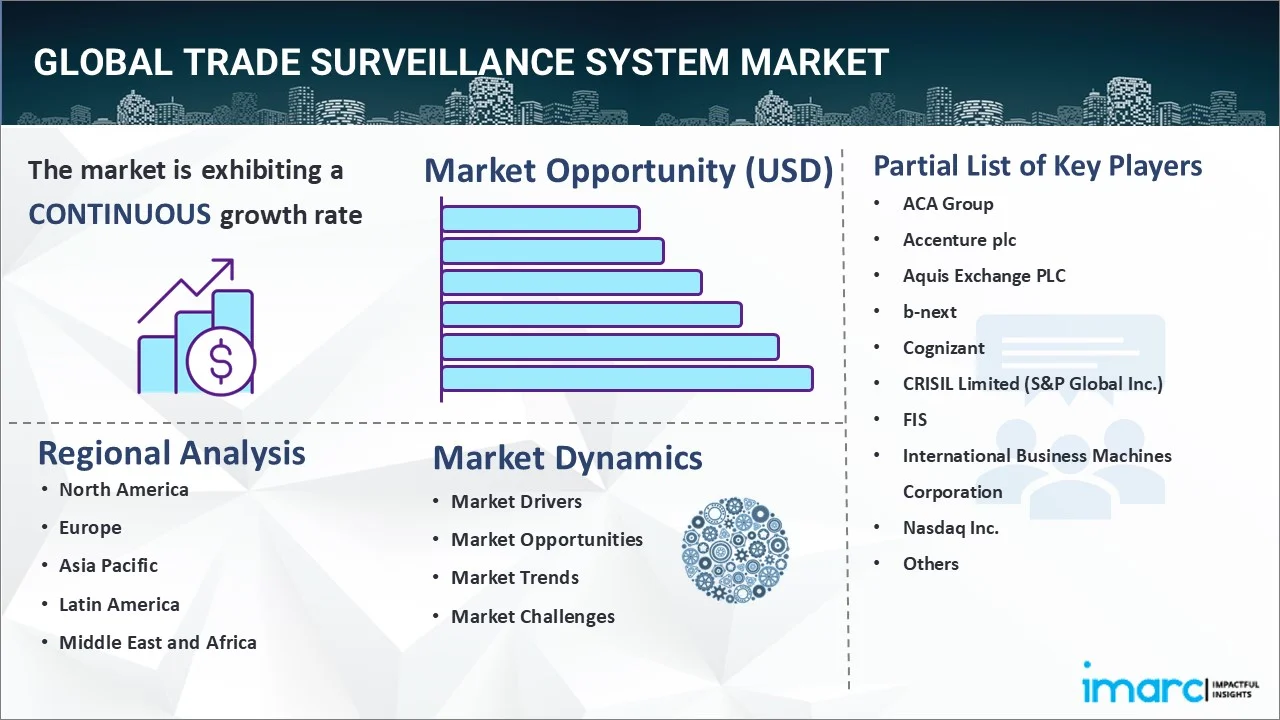
Trade Surveillance System Market Report by Component (Solutions, Services), Deployment Mode (On-premises, Cloud-based), Enterprise Size (Small and Medium-sized Enterprises, Large Enterprises), End User (Banks, Institutional Brokers, Retail Brokers, Market Centers and Regulators, and Others), and Region 2025-2033
Market Overview:
The global trade surveillance system market size reached USD 1,439.6 Million in 2024. Looking forward, IMARC Group expects the market to reach USD 5,097.0 Million by 2033, exhibiting a growth rate (CAGR) of 14.33% during 2025-2033.
|
Report Attribute
|
Key Statistics
|
|---|---|
|
Base Year
|
2024
|
|
Forecast Years
|
2025-2033
|
|
Historical Years
|
2019-2024
|
|
Market Size in 2024
|
USD 1,439.6 Million |
|
Market Forecast in 2033
|
USD 5,097.0 Million |
| Market Growth Rate 2025-2033 | 14.33% |
A trade surveillance system refers to an advanced software solution used to monitor and detect potential market abuse and other types of financial crimes. It works by capturing and analyzing trade data to identify illegal or unethical trading practices, such as fraud, behavioral patterning, market manipulation, unlawful disclosure, money laundering, insider trading, and unsuitable investments. It also assists organizations to ensure the efficient prevention and investigation of illegal, manipulative, or abusive trading practices to comply with the government regulations and protect the interests of the firm. As a result, trade surveillance systems are widely utilized by trade exchange firms, information technology (IT) service providers, government regulators, consulting firms, and other financial institutions.
Trade Surveillance System Market Trends:
The rising instances of abusive trading, market manipulation and fraud across the globe represent the primary factor driving the market growth. Besides this, the growing need for pre- and post-trade monitoring in financial institutions is augmenting the demand for trade surveillance systems. Additionally, there has been a substantial shift toward automated and algorithmic trading, which has increased the risk of trade manipulation, violation, and fraud. This, in confluence with the surging need for mandatory regulatory compliance, is propelling the market growth. Furthermore, the leading players are heavily investing in the development of advanced product variants integrated with innovative technologies, such as artificial intelligence (AI), natural language processing (NLP), and machine learning (ML), to gain a competitive edge. For instance, they have introduced solutions with enhanced surveillance and risk detection capabilities, an updated cloud architecture, and more powerful AI and NLP applications. Other factors, including rapid digitization, increasing cloud-based trading activities, technological advancements, and rising security concerns, are also creating a positive market outlook.
Key Market Segmentation:
IMARC Group provides an analysis of the key trends in each sub-segment of the global trade surveillance system market report, along with forecasts at the global, regional and country level from 2025-2033. Our report has categorized the market based on component, deployment mode, enterprise size and end user.
Breakup by Component:

- Solutions
- Services
Breakup by Deployment Mode:
- On-premises
- Cloud-based
Breakup by Enterprise Size:
- Small and Medium-sized Enterprises
- Large Enterprises
Breakup by End User:
- Banks
- Institutional Brokers
- Retail Brokers
- Market Centers and Regulators
- Others
Breakup by Region:

- North America
- United States
- Canada
- Asia-Pacific
- China
- Japan
- India
- South Korea
- Australia
- Indonesia
- Others
- Europe
- Germany
- France
- United Kingdom
- Italy
- Spain
- Russia
- Others
- Latin America
- Brazil
- Mexico
- Others
- Middle East and Africa
Competitive Landscape:
The competitive landscape of the industry has also been examined along with the profiles of the key players being ACA Group, Accenture plc, Aquis Exchange PLC, b-next, Cognizant, CRISIL Limited (S&P Global Inc.), FIS, International Business Machines Corporation, Nasdaq Inc., NICE Ltd., OneMarketData LLC and SIA S.p.A.
Report Coverage:
| Report Features | Details |
|---|---|
| Base Year of the Analysis | 2024 |
| Historical Period | 2019-2024 |
| Forecast Period | 2025-2033 |
| Units | Million USD |
| Segment Coverage | Component, Deployment Mode, Enterprise Size, End User, Region |
| Region Covered | Asia Pacific, Europe, North America, Latin America, Middle East and Africa |
| Countries Covered | United States, Canada, Germany, France, United Kingdom, Italy, Spain, Russia, China, Japan, India, South Korea, Australia, Indonesia, Brazil, Mexico |
| Companies Covered | ACA Group, Accenture plc, Aquis Exchange PLC, b-next, Cognizant, CRISIL Limited (S&P Global Inc.), FIS, International Business Machines Corporation, Nasdaq Inc., NICE Ltd., OneMarketData LLC and SIA S.p.A. |
| Customization Scope | 10% Free Customization |
| Post-Sale Analyst Support | 10-12 Weeks |
| Delivery Format | PDF and Excel through Email (We can also provide the editable version of the report in PPT/Word format on special request) |
Key Questions Answered in This Report
The global trade surveillance system market was valued at USD 1,439.6 Million in 2024.
We expect the global trade surveillance system market to exhibit a CAGR of 14.33% during 2025-2033.
The extensive utilization of trade surveillance system to monitor and detect market abuse, frauds, and other types of financial crimes, is primarily driving the global trade surveillance system market.
The sudden outbreak of the COVID-19 pandemic has led to the growing adoption of trade surveillance system across numerous businesses, for remotely preserving their critical data and monitoring several suspicious activities.
Based on the component, the global trade surveillance system market has been divided into solutions and services. Currently, solutions exhibit a clear dominance in the market.
Based on the deployment mode, the global trade surveillance system market can be categorized into on-premises and cloud-based, where on-premises currently hold the majority of the total market share.
Based on the enterprise size, the global trade surveillance system market has been segmented into small and medium-sized enterprises and large enterprises. Currently, large enterprises represent the largest market share.
Based on the end-user, the global trade surveillance system market can be bifurcated into banks, institutional brokers, retail brokers, market centers and regulators, and others. Among these, institutional brokers currently account for the majority of the global market share.
On a regional level, the market has been classified into North America, Europe, Asia-Pacific, Middle East and Africa, and Latin America, where Europe currently dominates the global market.
Some of the major players in the global trade surveillance system market include ACA Group,
Accenture plc, Aquis Exchange PLC, b-next, Cognizant, CRISIL Limited (S&P Global Inc.), FIS,
International Business Machines Corporation, Nasdaq Inc., NICE Ltd., OneMarketData LLC, and SIA S.p.A.
Need more help?
- Speak to our experienced analysts for insights on the current market scenarios.
- Include additional segments and countries to customize the report as per your requirement.
- Gain an unparalleled competitive advantage in your domain by understanding how to utilize the report and positively impacting your operations and revenue.
- For further assistance, please connect with our analysts.

 Inquire Before Buying
Inquire Before Buying
 Speak to an Analyst
Speak to an Analyst
 Request Brochure
Request Brochure
 Request Customization
Request Customization




.webp)




.webp)












